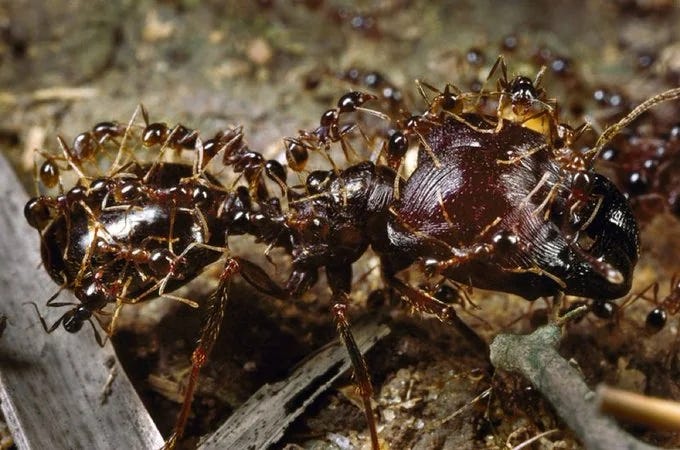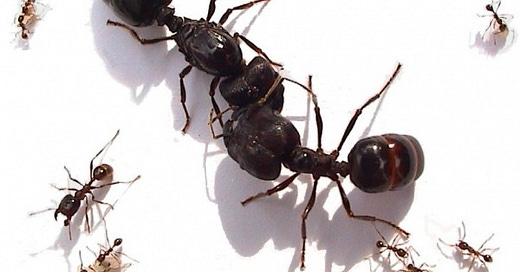Carebara diversa, commonly known as the Marauder Ant, is technically an Army Ant species due to its raiding behavior, but I personally do not see it as one since they aren’t nomadic. This ant has one of the largest queens and grows supermajor soldiers bigger than her majesty. The name Marauder Ant comes from the long trails they form to find food. Colony sizes vary from a few hundred to a few hundred thousand ants. These ants are also polygynous, meaning they can support up to 16 queens per colony.
Carebara diversa Queen and Super Major Next to Each Other.
Carebara diversa are gigantic, with the queens getting up to 20-25 mm and the supermajors ranging from 25-30 mm long. On the other side of the spectrum, the grunt workers range from 2.5-3 mm long, making them perfect for the delicate task of handling small broods. The Intermediate majors range from 10-15 mm long. This extreme polymorphism makes Carebara diversa an extremely popular ant in the ant-keeping world. Additionally, it also makes the ants more capable of varied tasks. The giant supermajors act as the security of the nest, making sure no intruder enters unabridged. The giant muscley mandibles of a supermajor would decimate any eggs it puts in its mouth, hence the need for small workers. The medium-sized majors also play the key role of breaking up tough food items, such as cockroach shells or seeds.
Carebara diversa are also extremely aggressive, killing everything they see. This behavior is due to the massive colony sizes and the need for multiple food sources a day to survive. They are opportunistic feeders, meaning that even the smallest morsel of food will attract a large swarm of ants. For larger food items, the large swarms are necessary because marauder ants like to skip the process of having to break down and transport the food in hundreds of trips. Instead, they carry the entire item back to their nest. This can take hours. To transport a cockroach about 100 feet, it can take up to an hour—now imagine how long it takes these hungry bastards to transport a cockroach 1-2 miles, the peak length of their food raids.
Small Workers Riding a Super Major Like A Bus to Food

Overall, these gigantic, hungry monsters will do anything for the tiniest drop of honey, sounds like my dog. They are huge and aggressive and can form trails longer than I can run, sometimes stretching 2 miles long. But unlike my dog, these ants will collaborate with terrifying efficiency, making them true monarchs of the ecosystem, built as more machine than ant, made for war. And when the machines see their rivals, they become hell bent on annihilation.






Jack, this was a fantastic deep dive into the world of Carebara diversa! I was amazed at the detail you went into regarding their extreme polymorphism and how each class plays such a specific role in their society. The comparison to the “machines made for war” is spot on—these ants are an incredible example of natural efficiency and teamwork at its finest.
It’s also fascinating how the colony size and feeding behavior influence their aggression. The way they work together to transport food, even massive items like cockroaches, shows just how well-oiled their system is. I can definitely see why Carebara diversa are so popular among ant-keepers. They’re not just aggressive, but also incredibly interesting from a behavioral perspective.
Looking forward to more of these insights, thanks for sharing! Keep ’em coming.
—Anton